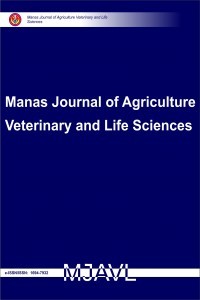The Concept of Welfare Assessment Protocol for Horses in Herd
herd of horses, animal welfare, animal welfare assessment, animal welfare assessment protocol equine welfare assessment protocol concept,
___
- AHIC: Australian Horse Industry Council 2011. Australian Horse Welfare Protocol. Available: http://www.horsecouncil.org.au/ahic/
- Aldashev AA 1989. Mal charbasynyn zhana veterinariya terminderinin oruscha-kyrgyzcha sөzdүgү. Kyrgyzstan, Frunze (in Kyrgyz).
- AWIN 2015. AWIN welfare assessment protocol for horses. DOI: 10.13130/AWIN_HORSES, 2015.
- Blokhuis HJ, Miele M, Veissier I, Jones B 2013. Improving farm animal welfare: science and society working together: the welfare quality approach. Wageningen: Wageningen Academic Publishers, 232.
- Broom DM, Johnson KG 1993. Stress and Animal Welfare, 1st ed.; Kluwer Academic Publishers: Dordrecht, The Netherlands, 211.
- EC: European Convention for the Protection of Animals kept for Farming Purposes 1976. ETS No.087. Strasbourg, 10/03/1976. https://www.coe.int/en/web/conventions/full- list/-/conventions/treaty/087
- Ivanov AA, Ksenofontova AA, Voynova OA 2012. Otsenka urovnya blagopoluchiya loshadey po fiziologo-gematologicheskim i etologicheskim pokazatelyam pri raznykh tekhnologiyakh soderzhaniya. Izvestiya TSKHA, 6: 159 164. (in Russian).
- KRUSK (Kyrgyz Respublikasynyn uluttuk statistikalyk komiteti). Zhylky sany 2021. http://www.stat.kg/ru/ (kayryluu datasy: 10.06.2021). (in Kyrgyz).
- Kyrgyz elinin uyutkuluu syrlary 2013. Zhylky. Birinchi basylyshy. Bishkek, Kut Ber, 103. (in Kyrgyz).
- Kөchmөndөrdүn zhayyttary («Mal baguuchularga zhardam katary salttuu bilimderdin» seriyasy) 2011. Tүz. K. Shapakov, RDF. Bishkek, Mara, 42. (in Kyrgyz).
- Lesimple C 2020. Indicators of Horse Welfare: State-of-the-Art. Animals. 10(2): 294. https://doi.org/10.3390/ani10020294
- OIE: Animal welfare 2021. https://www.oie.int/en/animal-welfare/animal-welfare-at-a-glance/ (кайрылуу датасы: 10.06.2021).
- Rollin BE 1993. Animal welfare, science, and value. J. Agric. Environ. Ethic. 6: 44 50.
- Sommerville R, Brown AF, Upjohn M 2018. A standardised equine-based welfare assessment tool used for six years in low and middle income countries. PLoS ONE 13(2): e0192354. https://doi.org/10.1371/journal.pone.0192354
- Sorensen J, Sandoe P, Halberg N 2001. Animal welfare as one amongst several values to be considered at farm level: the idea of an ethical account for livestock farming. Acta Agr. Scand. A: An Suppl., 30: 1116.
- Statens Jordbruksverk 2009. Vägledning för kontrollmyndigheter m.fl. Bilaga Checklista häst version 1.0. Statens Jordbruksverk, Sverige.
- Sterling P, Eyer J 1988. Handbook of life stress, cognition and health. In Allostasis: A New Paradigm to Explain Arousal Pathology; Fisher S, Reason J, Eds.; Wiley: New York, NY, USA, 629– 649.
- Sydykbekov K 2016. Konevodstvo Kirgizstana i Perspektivı Razvitiya Plemennogo Konevodstva. Vestnik Kyrgyz national agrarian university after K.I. Skryabin. 3(39): 74 76. (in Russian).
- Tulobaev A 2020. Defining criteria for assessing the welfare of horses bred in range conditions in Kyrgyzstan. Manas Journal of Agriculture Veterinary and Life Sciences. 10(2): 110 115. (in Turkish).
- Tulobaev A, Niyazbekova Z, Askarbek G, Jorubaev S 2018. Specificities of Horse-Herd Keeping the Kyrgyz Horse. Vestnik Kyrgyz national agrarian university after K.I. Skryabin. 2(47): 183 187. (in Kyrgyz).
- Turdubaev TJ, Imanov KE, Kashykeev KS 2014. Importance and current state of horse breeding in Kyrgyzstan. Vestnik Kyrgyz national agrarian university after K.I. Skryabin. Bishkek, 1 (30): 183 185. (in Russian).
- Uoring DKH 2007. Povedeniye loshadi. SPb.: Gramota-Plyus, 153. (in Russian).
- Viksten SM, Visser EK, Blokhuis HJ 2016. A comparative study of the application of two horse welfare assessment protocols. Acta Agriculturae Scandinavica, Section A – Animal Science. 66, 1: 56 65. http://dx.doi.org/10.1080/09064702.2016.1186726.
- Visser EK, Neijenhuis F, de Graaf-Roelfsema E, Wesselink HGM, de Boer J, van Wijhe-Kiezebrink MC, van Reenen CG 2014. Risk factors associated with health disorders in sport and leisure horses in The Netherlands. Journal of Animal Science, 92, 844855.
- Zhayyttardyn menedzhmenti: Fermerlerdin praktikalyk kөndүmdөrүn zhakshyrtuu boyuncha modul' 2017. Tүzүүchүlөr: ZH. Kozhomuratova, U. Fisher-Zuykov, A. Isakov, S. Dzhumabayeva, A. Imanaliyev. Bishkek, 64. (in Kyrgyz).
- ISSN: 1694-7932
- Yayın Aralığı: 2
- Başlangıç: 2013
- Yayıncı: KIRGIZİSTAN-TÜRKİYE MANAS ÜNİVERSİTESİ
Yasemin ÇİÇEK YILDIZ, Ahmed Eısa ELHAG, Zafer YAZICI
Tair ESENALI UULU, Elaman KANATBEK UULU, Şenol YILDIZ
MAPK Modüllerinin Bitki İmmünitesindeki Yolculuğu
Yaşar ERTÜRK, Ramazan CAKMAKCI, Meral KUTLU, Hakan KELES
Van İli Koyunlarında Dictyocaulus filaria’nın Moleküler Karakterizasyonu
Murat ÖRÜN, Vural DENİZHAN, Ayşe KARAKUŞ
Osman GEDİK, Yusuf Ziya KOCABAŞ, Orçun ÇINAR
Dilek KANDEMİR, Güldane Tuğba ŞAHİN, Ahmet BALKAYA, Şeyma SARIBAŞ
